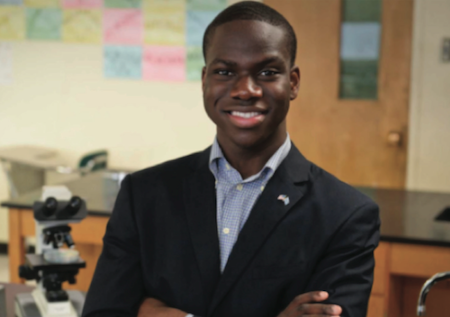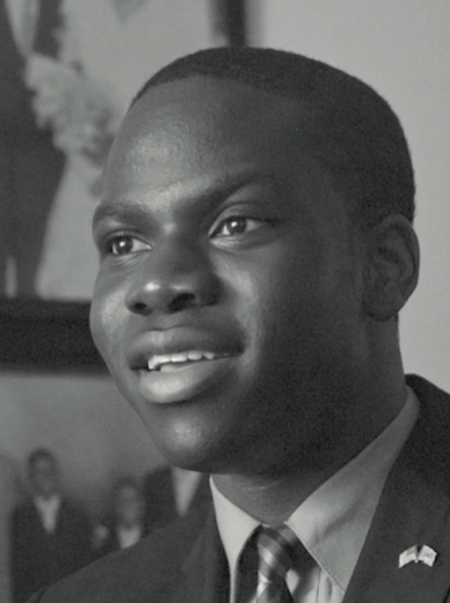April 10, 2015

Harold Ekeh
Nearly one year ago, YG&B featured an April 12, 2014 article on Shirley, New York’s Kwasi Enin’s acceptance into all eight of the nation’s top Ivy League schools.
Who would have known that almost to the day a year later, this series would again have the opportunity to profile yet another teen scholar, of the same age as Kwasi at the time, who achieved the exact same accomplishment.
He is young, gifted & Black. Harold Ekeh, a senior at Elmont Memorial High School in Long Island, New York has been accepted into all eight of the country’s top Ivy League schools – Brown, Columbia, Cornell, Dartmouth, Harvard, Princeton, the University of Pennsylvania and Yale.
And we should mention also that he additionally received acceptance letters from MIT, Johns Hopkins University, NYU, Stony Brook University and Vanderbilt University.
“I am leaning towards Yale,” as quoted in a Sarah Schlott post. “I competed at Yale for Model UN and I like the passion people at Yale had.”
Harold visited Yale with his team’s Model UN program. Model UN (MUN) is an academic engagement where students learn about diplomacy, international relations and the United Nations. MUN immerses its select students in the instruction of research, public speaking, debate, writing skills, teamwork, critical thinking, and in leadership.
The Schlott posting further reveals that some of the Yale students he met became his close friends and mentors, sharing advice on the college application process.
Harold is now giving back this mentored opportunity by founding a mentoring program at his Elmont school in the New York City suburbs. His objective is to assist in getting more students into top universities. Elmont Memorial is 99% minority.
The son of Ghanaian immigrants, Kwasi Enin, 18, is attending Yale and is near completion of his freshman year.
Born in his native home of Nigeria, Harold came to the United States with his parents when he was eight. He actually prepared his college essay on the challenges he had adjusting to a new county and the difficulty of learning U.S. History.
“It was very difficult to adjust,” he admits in the New York Post on April 5, 2015. “I spoke English, but with a very heavy accent. It was like, ‘What is this kid saying?’” he adds.

He would constantly ask his parents why they decided to move to America.
“We had a fairly comfortable life in Nigeria, but they told me we moved to America for the opportunities, like the educational opportunities.”
“I am just thinking God for what he is doing for my family in the life of my son,” says his mother Roseline in a CBS New York writing. Roseline works in Queens for a human resource agency and his father, Paul, is employed by the NYPD traffic division.
“I am overwhelmed. To say that I am proud is not enough. It is awesome,” he says in CBS of his son’s achievements.
The salutatorian of his senior class, Harold has earned a GPA of 100.51 and scored 2250 out of 2400 on the SAT. He directs the youth choir at his church, plays the drums, is a member of the Key Club at his school, is editor-in-chief of the school newspaper, vice president of his Elmont’s Model UN chapter, and was elected to the Homecoming Court.
He speaks Igbo and Spanish and, according to CNN Money, is extremely proud that he aced the AP History exam despite his earlier difficulties with the subject.
“Standardized test scores and good grades will get a student in the door to have their application read,” says Rachel Rubin in April 3, 2015’s This Island Now. “But it’s their extracurricular activities, leadership experience, exceptional talents, recommendation letters and personal essays that will move a student from a pile of ‘maybes’ to a pile of ‘accepted.’ “
He has a passion for science, according to CNN, and his vision is to major in neurobiology or chemistry in college towards the goal of later becoming a doctor and ultimately a neurosurgeon.
Harold was named a 2015 Intel Science Talent Search semifinalist earlier this year for his research on how the acid DHA can slow Alzheimer’s. And for this doctor becoming, this research was personal.
As cited in This Island Now, he was a semifinalist for his research titled, “The Role of PARP-1 in MeHg-induced dopaminergic dysfunction and mitochondrial DNA depletion” where he found that certain toxins cause degradation of motor skills and lead to the diseases of Parkinson and Alzheimer’s.
His grandmother was diagnosed with Alzheimer’s when he was 11 and as noted in CNN Money, one of his proudest moments was running home to tell his parents and his aunts about the breakthrough he was finding with DHA.
“If there is any way I can work to prevent this, I want to,” he is quoted as saying.
He adds in CBS New York that when, “Kids would say, ‘I want to be a firefighter or a police officer or a superhero,’ I would say I want to explore the human body, what makes us who we are. I would like to be a neurosurgeon when I grow up.”
His principal, John Capozzi, says of the senior in published quotes that he, “really represents Elmont Memorial High School. No one is more determined than Harold.”
He describes in CNN Money that the lab where Harold did his award-winning research is modest and only staffed part-time by a “passionate chemistry teacher” but that our community makes the most of what it has.
Harold will spend the coming weeks visiting all the schools before making his final decision.
“I still have to make visits to other schools like Harvard, Princeton and MIT,” he says in Yahoo News as he looks forward to the opportunity to take college courses that “spark my intellectual curiosity.”
He credits his parents for challenging him to study and to do his best, “no matter how hard times got,” he positions in New York Post. He adds that, “Anybody who sees my story can say, ‘if he can do it, I can do it.’ I’m just a kid who had a real strong support system.”
Harold in CBS New York reveals his personal reflections that, “I am very humbled by this. I see this as not an accomplishment for me, but as an accomplishment for my school and for my community because I really see this as my mission to inspire the next generation.”

